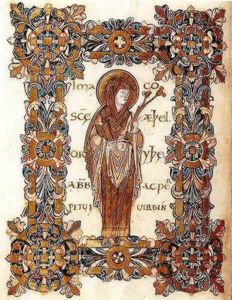 |
In the twentieth century we often find it difficult to understand the role played by the Church in the tenth and eleventh centuries. Consequently, we often pick up odd misconceptions and attitudes.
At all levels of society, from eorl to theow, belief in a god or gods was not a matter of choice, it was a matter of fact. Atheism was an alien concept (and one dating from the eighteenth century). Living in the middle ages, you would come into contact with the Church in a number of ways.
First, there were the routine church services, held daily and attended at least once a week, and the special festivals of Christmas, Easter, baptisms, marriages, etc.. In that respect the medieval Church was no different to the modern one.
Second, there were the tithes that the Church collected, usually once a year. Tithes were used to feed the parish priest, maintain the fabric of the church, and to help the poor.
Third, the Church fulfilled the functions of a 'civil service' and an education system. Schools did not exist (and were unnecessary to a largely peasant society), but the Church and the government needed men who could read and write in English and Latin. The Church trained its own men, and these went to help in the government: writing letters, keeping accounts and so on. The words 'cleric' and 'clerk' have the same origin, and every nobleman would have at least one priest to act as a secretary.
The power of the Church is often over-emphasised. Certainly, the later medieval Church was rich and powerful, and that power was often misused - especially in Europe. Bishops and archbishops were appointed without any training or clerical background, church offices changed hands for cash, and so on. But that was long after our period. The authority of the early medieval Church in England was no different to that of any other landowner.
So how did people in the tenth/eleventh century act towards a cleric? According to the laws of the period, a priest had the rank of thegn (he was one of 'God's thegns'), and a bishop was at least the level of an eolderman. Don't get too misled by Hollywood's image of popular contempt for, and corruption within, the clergy.
Click here to return to the village.
Click here to return to St. Werberg's Mynster.
Click here to return to St. Alphege's Church.